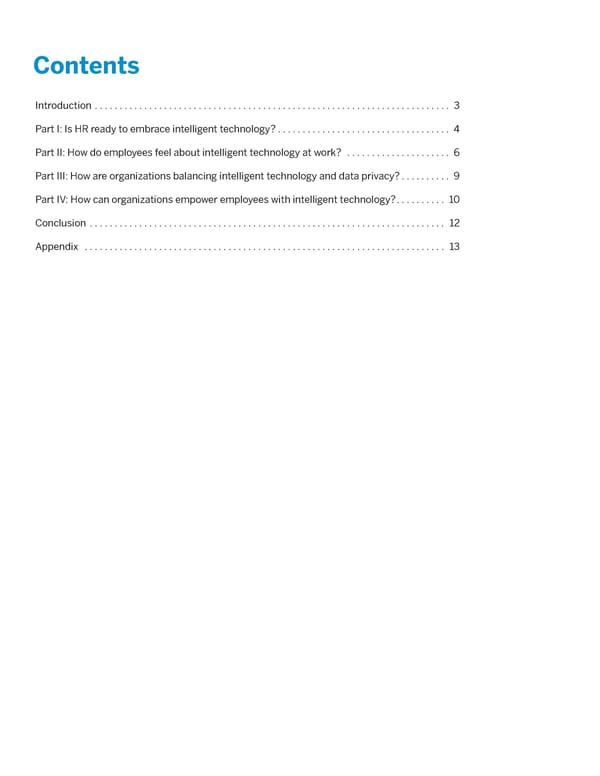Empowering Employees and Organizations with Intelligent HR Technology
Microsite | SAP White Paper
SAP White Paper | PUBLIC Empowering Employees and Organizations with Intelligent HR Technology
Contents Introduction ⸀ ⸀ ⸀ ⸀ ⸀ ⸀ ⸀ ⸀ ⸀ ⸀ ⸀ ⸀ ⸀ ⸀ ⸀ ⸀ ⸀ ⸀ ⸀ ⸀ ⸀ ⸀ ⸀ ⸀ ⸀ ⸀ ⸀ ⸀ ⸀ ⸀ ⸀ ⸀ ⸀ ⸀ ⸀ ⸀ ⸀ ⸀ ⸀ ⸀ ⸀ ⸀ ⸀ ⸀ ⸀ ⸀ ⸀ ⸀ ⸀ ⸀ ⸀ ⸀ ⸀ ⸀ ⸀ ⸀ ⸀ ⸀ ⸀ ⸀ ⸀ ⸀ ⸀ ⸀ ⸀ ⸀ ⸀ ⸀ ⸀ ⸀ ⸀ ⸀ 3 Part I: Is HR ready to embrace intelligent technology? ⸀ ⸀ ⸀ ⸀ ⸀ ⸀ ⸀ ⸀ ⸀ ⸀ ⸀ ⸀ ⸀ ⸀ ⸀ ⸀ ⸀ ⸀ ⸀ ⸀ ⸀ ⸀ ⸀ ⸀ ⸀ ⸀ ⸀ ⸀ ⸀ ⸀ ⸀ ⸀ ⸀ ⸀ ⸀ 4 Part II: How do employees feel about intelligent technology at work? ⸀ ⸀ ⸀ ⸀ ⸀ ⸀ ⸀ ⸀ ⸀ ⸀ ⸀ ⸀ ⸀ ⸀ ⸀ ⸀ ⸀ ⸀ ⸀ ⸀ ⸀ 6 Part III: How are organizations balancing intelligent technology and data privacy? ⸀ ⸀ ⸀ ⸀ ⸀ ⸀ ⸀ ⸀ ⸀ ⸀ 9 Part IV: How can organizations empower employees with intelligent technology? ⸀ ⸀ ⸀ ⸀ ⸀ ⸀ ⸀ ⸀ ⸀ ⸀ 10 Conclusion ⸀ ⸀ ⸀ ⸀ ⸀ ⸀ ⸀ ⸀ ⸀ ⸀ ⸀ ⸀ ⸀ ⸀ ⸀ ⸀ ⸀ ⸀ ⸀ ⸀ ⸀ ⸀ ⸀ ⸀ ⸀ ⸀ ⸀ ⸀ ⸀ ⸀ ⸀ ⸀ ⸀ ⸀ ⸀ ⸀ ⸀ ⸀ ⸀ ⸀ ⸀ ⸀ ⸀ ⸀ ⸀ ⸀ ⸀ ⸀ ⸀ ⸀ ⸀ ⸀ ⸀ ⸀ ⸀ ⸀ ⸀ ⸀ ⸀ ⸀ ⸀ ⸀ ⸀ ⸀ ⸀ ⸀ ⸀ ⸀ ⸀ ⸀ ⸀ ⸀ 12 Appendix ⸀ ⸀ ⸀ ⸀ ⸀ ⸀ ⸀ ⸀ ⸀ ⸀ ⸀ ⸀ ⸀ ⸀ ⸀ ⸀ ⸀ ⸀ ⸀ ⸀ ⸀ ⸀ ⸀ ⸀ ⸀ ⸀ ⸀ ⸀ ⸀ ⸀ ⸀ ⸀ ⸀ ⸀ ⸀ ⸀ ⸀ ⸀ ⸀ ⸀ ⸀ ⸀ ⸀ ⸀ ⸀ ⸀ ⸀ ⸀ ⸀ ⸀ ⸀ ⸀ ⸀ ⸀ ⸀ ⸀ ⸀ ⸀ ⸀ ⸀ ⸀ ⸀ ⸀ ⸀ ⸀ ⸀ ⸀ ⸀ ⸀ ⸀ ⸀ ⸀ ⸀ 13
Introduction In HR, use cases of intelligent technology – for example, arti昀椀cial intelligence (AI) and machine learning (ML) – are becoming increasingly common ⸀ Whether it’s used to identify the right talent for employers, to provide targeted skills and learning recommendations for employees, or to leverage chatbots that improve service delivery across the organization, HR is beginning to realize the signi昀椀cant value that intelligent technology can o昀昀er. Yet according to research by IDC1, understanding where and how to implement intelligent technology is one of the top 10 challenges HR is grappling with today ⸀ HR needs guidance as to where these technologies will o昀昀er the most value, both to the organization and to employees, and Intelligent technology which use cases will be met with the least resistance ⸀ Better understanding employees’ comfort, preferences, and concerns related to the use of is de昀椀ned as any intelligent technology is critical to ensuring organizational success and that technology that can intelligent technology will enhance, rather than detract, from employees’ perform human-like experience at work ⸀ activities, such as learning, problem To help better understand the impact of intelligent technology2 on employees solving, or decision and organizations, the Growth & Insights team for SAP® SuccessFactors® making, without the solutions hosted interviews with 41 HR leaders from SAP customer assistance of a human ⸀ organizations and conducted a survey of 1,378 employees from around the globe ⸀ Our research focused on the following questions: •What is the current state of organizational adoption of intelligent technology for HR use cases, and what future trends are on the horizon? • How do employees feel about the idea of intelligent technology at work, generally, and about intelligent technology for speci昀椀c HR use cases? •What are the critical privacy and ethical considerations related to the use of intelligent technology in HR? • How can organizations facilitate the right conditions to increase employee acceptance and foster adoption of intelligent technology in HR? 1IDC, Market Analysis Perspective: Worldwide Modern Human Resources Strategies and Opportunities, 2022, Doc # US49130622, September 2022 2 Since originally conducting this research, advances in generative AI and Large Language Models (LLMs) have attracted signi昀椀cant public attention on the impact of intelligent technologies across all aspects of our lives. While the present research did not look speci昀椀cally at generative AI models such as ChatGPT, our broader focus and 昀椀ndings related to intelligent technology in HR, generally, would have applicability to this use case.
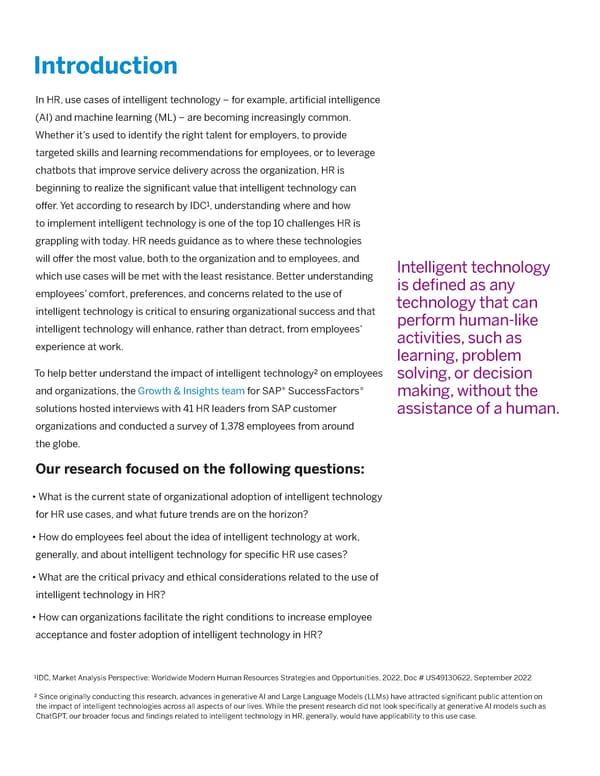
Part I: Is HR ready to embrace intelligent technology? of where to start), or, somewhere in between? Not surprisingly, our It was important for us to 昀椀rst understand organizations’ levels of maturity related to intelligent technology adoption ⸀ Were results showed a wide dispersion of maturity across the organizations organizations aggressively adopting these technologies, waiting for we spoke with ⸀ them to 昀椀rst prove their value, actively avoiding adoption (unsure “Non-Active” (44%) “Reactive” (22%) “Proactive” (34%) • These companies were grappling with • These companies were often in process • These companies tended to be early immaturity of org from digitalization of broader digital transformation, and adopters of technology in general, staying perspective generally, often dealing with viewed adoption of intelligent technologies abreast of major trends and new/emerging existing legacy systems as a priority technologies • Unsure where or how to start their journey • Waited for technologies to prove • Actively adopting intelligent technologies with intelligent technology and are seeking themselves before adopting, but now feel across employee journey, though use cases external guidance prepared to act still tend to be relatively basic • May have adopted very simple use • Question how quickly they can mobilize to • Sometimes have small team dedicated to cases (for example, chatbot) but have deliver more mature vision building these technologies in-house not considered adoption across employee journey Figure 1: The three maturity levels of organizations’ intelligent technology adoption in HR
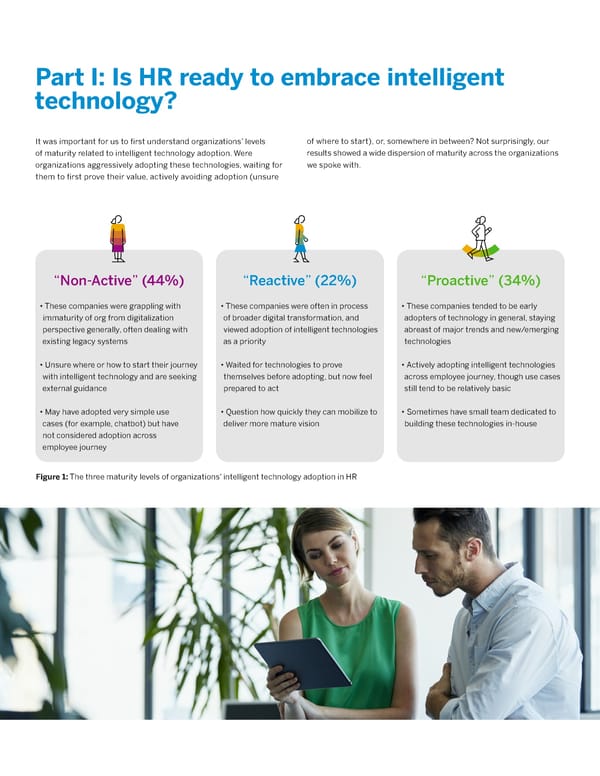
Importantly, nearly all organizations we spoke with indicated a desire to increase their maturity, the most popular reasons cited by HR leaders being to: 1. Ensure the longevity of their business 3. Make better use of their data “If we continue to use old technologies as a business in the tech space, we “Data is abundant today, and AI is the di昀昀erentiator for how to make that are doomed.” data meaningful and use it to drive meaningful change.” 2. Improve employee experience (EX) 4. Retain top talent “EX is everything. If we can improve it through AI/ML, that’s reason “The world is changing and if you don’t retain your talent, you’re in trouble. enough to adopt.” The shift became very clear as a result of the pandemic.” However, organizations also cited a number of Organizational Legal challenges that make increasing their maturity • Cost • Lack of AI authority feel like an uphill battle: • Stakeholder buy-in • Varying legal from country to country • Accountability for delivering results • Uncertainty • Inconsistent priorities • Data leaks/hacks/security risks • HR excluded from technological investment conversations Technical Employee • Complicated integrations • Distrust • Data quality and availability • Lack of perceived value • Work needed to trainchatbots • Tech overload/fatigue • Biased data and algorithm development • Change management required • Lack of education about tech purpose & operation Figure 2: Reported challenges to adopting and using intelligent technologies in HR
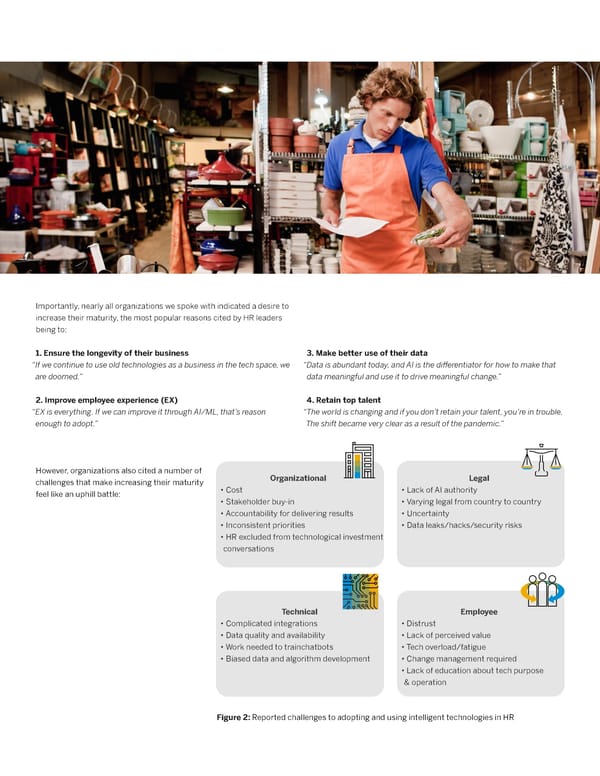
Where are organizations investing today? What trends are on the horizon? A key di昀昀erentiator amongst those more and less mature organizations recruiting and learning were the two highest priority areas for adoption was the breadth of their adoption of intelligent technology ⸀ Although less as of today, but interestingly were expected to be deprioritized in the near mature organizations tended to have adopted only a single use case or future to make room for use cases that support employees and internal several basic use cases in one HR area, more mature organizations had mobility ⸀ explored adoption of intelligent technology across the entire employee journey ⸀ Interviews with our customer organizations revealed that Key HR areas and use cases: Current and future adoption priorities Current Future HR Area Use Cases Priority Priority Recruiting CV matching, automated scheduling & interviewing, chatbots, “Tinder Pro昀椀le” for # 1 employees Learning Learning recommendations/“pathways” (what employee needs now, next, and what # 2 skills org needs), VR learning Employee Engagement Chatbot (for admin and more complex tasks), HR self-service & ticketing Intelligent # 3 employee engagement platform Internal Mobility Skill pro昀椀les and career paths, opportunity # matching, succession identi昀椀cation 4 Analytics* Workforce planning, skill planning # 5 Figure 3: *While our primary focus is employee-facing examples of intelligent tech in HR, there are also “back office” use cases HR currently/plans to leverage .
Part II: How do employees feel about intelligent technology at work? Our research revealed that decisions related to the adoption of intelligent Although the media has often depicted employees as being fearful of and technology do not sit solely with HR, but rather span across other resistant toward intelligent technology at work, our employee survey data decision-makers in the C-suite as well as legal, compliance, and other paints a more nuanced picture ⸀ The apprehension may exist, but so does groups ⸀ However, we would argue that employees too should have a voice a sense of optimism and excitement about the potential value that these (whether implicit or explicit) in the intelligent technology and use cases technologies bring ⸀ that an organization implements ⸀ Emotions elicited by intelligent technology* Afraid Distressed Apprehensive Excited Content Optimistic 25% 26% 44% 74% 75% 80% *% of employees who selected “yes” vs ⸀ “no” Indeed when we asked employees what they felt were the biggest employees” and 81% agreed or strongly agreed, “I trust that my company motivations behind companies adopting intelligent technology, the more would use intelligent technology responsibly ⸀” negative sentiments (for example, “to get employees to work longer and harder” or “to automate or eliminate jobs”) were rated as the weakest Taken together, these 昀椀ndings suggest that employees are not inherently motivations, while positive bene昀椀ts such as “to help employees do their starting from a baseline of skepticism or distrust ⸀ Therefore, organizations jobs more e昀昀ectively” or “to give employees more 昀氀exibility in how they have an opportunity to secure and build upon that trust by creating the work” were rated as the strongest ⸀ right conditions whereby intelligent technology enhance – rather than detract from – their experience ⸀ And, when it comes to responsible adoption, it turns out that employees genuinely trust their employers. Our survey data shows that 75% of Trust starts by understanding the speci昀椀c use cases that employees are employees agreed or strongly agreed with the statement, “I trust that comfortable with, and those that they feel are invasive or not bene昀椀cial. my company would only adopt intelligent technology that bene昀椀tted Employees rated the following reasons the strongest Employees rated the following reasons the weakest motivations behind companies adopting intelligent motivations behind companies adopting intelligent technologies: technologies: 1. To improve company’s overall e昀케ciency 1 ⸀ To provide employees with a more personalized experience 2. To help employees do their jobs more e昀昀ectively 2 ⸀ To automate or eliminate employees’ jobs 3. To give employees more 昀氀exibility in how they worked 3 ⸀ To get employees to work longer and harder Figure 4: Employees are generally positive about intelligent technologies at work ⸀
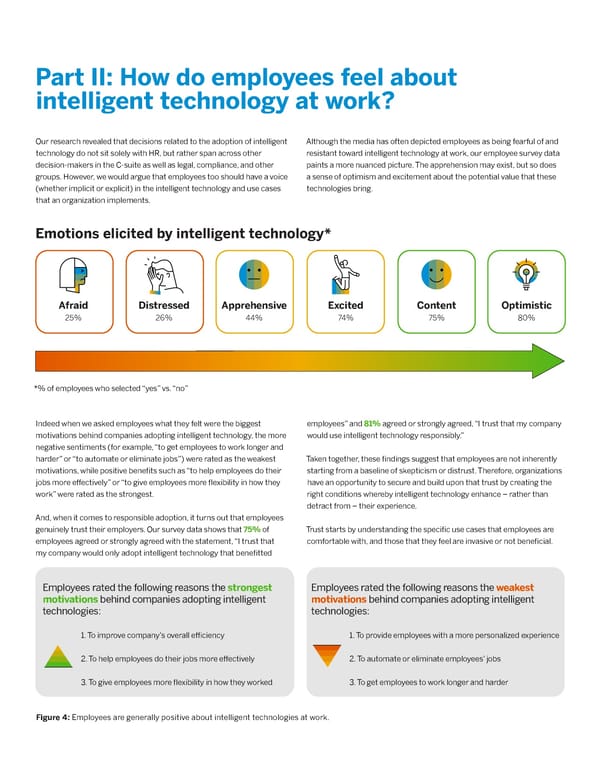
Assessing employee acceptance of intelligent technology use in HR We asked employees to rate their comfort with 22 di昀昀erent HR use When we dug into the data to understand which speci昀椀c use cases cases of intelligent technology (the full list appears in the Appendix) ⸀ employees most and least preferred, we found that employees felt Across all use cases, only 23% of our respondents would be considered most positively about instances where intelligent technology enabled “promoters” (for example, proponents of intelligent technology, them to do their work more e昀昀ectively, such as 昀椀nding relevant in general) whereas 35% would be considered “detractors” (for documents, answering basic questions, or identifying learning courses example, skeptical of intelligent technology, in general), leaving 42% they should take ⸀ Employees felt most negatively about use cases as “passives” (for example, do not have a strong sentiment toward where intelligent technology was used to evaluate them, such as to intelligent technology, in general). This indicates, 昀椀rst, that employees assess their performance, 昀椀t with a job, or skill level. are indeed discerning about the application of intelligent technology in the workplace, and second, that organizations have an opportunity to increase overall acceptance and adoption by turning those employees who are currently “passive” into promoters ⸀ People want technology to enable them ⸀ ⸀ ⸀ People do not want technology to evaluate them ⸀ ⸀ ⸀ • Calculating the number of hours I spend working each day • Conducting my exit interview when I leave a company • Answering my basic HR questions • Analyzing my performance in a job interview • Completing basic HR tasks • Assessing how well I communicate with others • Suggesting relevant HR documents and instructions • Determining my 昀椀t with a job I applied for • Suggesting learning courses I should take • Determining how well I am able to withstand challenges at work • Calculating my pay increase • Measuring my stress at work and risk of quitting • Analyzing my leadership (for example, how often I provide feedback or recognition to coworkers) Figure 5: Turning detractors into passives and passives into promoters: Where to start and what use cases to avoid Our take on these 昀椀ndings is not to suggest that organizations should door” to further adoption ⸀ And for those use cases that do encounter only adopt administrative use cases of intelligent technology, nor is it resistance from employees, we urge organizations to take employee to say that organizations should automatically and necessarily avoid sentiment into account and to consider how they can increase use cases where intelligent technology is used in a more evaluative employees’ sense of trust and comfort ⸀ We discuss best practices sense ⸀ Rather, we believe that these results can be used to help for increasing employees’ acceptance and adoption of intelligent organizations know “where to start” – in other words, which use cases technology in part IV ⸀ are likely to be met with least resistance and can serve as a “foot in the
Are HR and employees on the same page? We wanted to understand the extent to which HR’s stated current and Again, we do not include these 昀椀ndings to suggest that organizations future areas for intelligent technology investment matched up with the should avoid consider adopting intelligent technology for these two use areas that employees feel most comfortable and receptive toward ⸀ cases ⸀ Rather, we want to reiterate the importance of understanding employees’ concerns around recruiting and career pathing use cases Our data suggests good alignment in general, but two particular areas speci昀椀cally so that interventions can be designed to increase trust and where HR and employees disagree are the use of intelligent technology acceptance ⸀ for recruiting and career pathing ⸀ Where are HR and Employees aligned? Where are HR and Employees misaligned? Both HR and employees like intelligent technology for: HR and employees disagree on the use of intelligent technology for: • Learning new skills • Development opportunities • Recruiting automation • HR self-service • Career pathing Both HR and employees dislike intelligent technology for: • Sensitive data • Evaluation (of performance, potential, etc ⸀) • Employee monitoring Figure 6: Use case desirability: Are employees and HR aligned?
Part III: How are organizations balancing intelligent technology and data privacy? Perhaps more than any other topic, the privacy and ethical considerations related to the use of intelligent technology have been “Can and will this data ever be used front and center in the popular and business press ⸀ The organizations against employees? Can we delete we spoke with as part of our research echoed the critical importance of data privacy and compliance, with many taking a “better safe than sorry” records and be sure that the data is approach, adopting the strictest possible privacy standards (for example, deleted everywhere in the system? GDPR1) even when not required by law ⸀ What are and aren’t employees For employees, key privacy and ethical concerns relate to levels of comfortable with? These are all transparency as to how the intelligent technology works, the accuracy and equity of decisions generated, and the sources of data used by the extremely important questions to technology ⸀ us ⸀” – HR leader Indeed, when asked about a variety of di昀昀erent data sources, our survey results show that employees are most comfortable with intelligent technology accessing work-related data sources such as work calendars, active status, time tracking, and e-mails, and least comfortable with intelligent technology accessing data related to their physical body, such as their tone of voice, eye movement, body language, or facial expressions ⸀ While this result on its own may not be altogether shocking, it is an important reminder that in the case of intelligent technologies, the “means” are just as important for organizations to consider as the “ends ⸀” Employee Comfort Rating 3 ⸀5 3 ⸀4 3 ⸀3 3 ⸀2 3 ⸀1 3 ⸀0 2 ⸀9 2 ⸀8 2 ⸀7 2 ⸀6 2 ⸀5 s s y s e s e e t or x at t Calls ation Te oic sion mails ement s acking E f V e e St r o ement v anguag Calendar v xpr ctiv ernet His one e Mo A Time T ommunic T al Mo y ody L Int sic E B acial E y F Chat C Ph Figure 7: Certain data sources are more likely to violate employees’ privacy expectations ⸀ 1GDPR – The General Data Protection Regulation, a data privacy and security law in the European Union.
Part IV: How can organizations empower employees with intelligent technology? When it comes to introducing intelligent technology in the workplace “Rarely can you overcommunicate and driving a positive experience for employees, our research suggests to employees – especially when it the following best practices: comes to adoption of technology ⸀” –HR leader 1. Provide employees with more information about the purpose and 3. Give employees autonomy where possible scope of the technology It is important that employees have a sense of autonomy and To make employees feel more comfortable with and willing to use ownership when it comes to their data ⸀ As discussed earlier, many of intelligent technology, transparency is key, as one of the HR leaders the organizations we spoke with are taking an extremely conservative we interviewed stated ⸀ Indeed, of 44 interventions tested in our approach to data management and asking critical questions around survey, we found that “Providing employees more information about ability to access and delete data permanently ⸀ This is top of mind for the data intelligent technology uses” (#1) and “Providing employees employees as well. Our survey data shows that employees rated “The more information about how the intelligent technology works” (#2) ability to access any data collected by intelligent technology upon were rated most important to increasing employees’ willingness to request” and “Allowing employees to opt out of any systems collecting use intelligent technology ⸀ It is also in organizations’ best interests data that they are not comfortable with” as the #4 and #5 most to provide employees with more transparency around where their important interventions (out of 16) for increasing their willingness to data is stored, how it will and won’t be used, and the rationale use intelligent technology ⸀ behind organization adopting the intelligent technology ⸀ In fact, “Understanding the bene昀椀ts associated with the use of the technology (for example, “what’s in it for me?”)” was rated the second most important intervention by those “detractor” respondents in our survey, suggesting that this information is particularly important for getting more skeptical employees on board ⸀ 2. Ensure decision accuracy and equity One of the biggest concerns associated with the use of AI discussed in the popular and business press is bias. In fact, IDC1 predicts that by 2025, 50% of the Global 2000 will increase data scientist diversity by 50% to help mitigate AI bias and errors in development and model training ⸀ According to our own employee survey data, “Conducting tests to ensure decisions and recommendations generated by the intelligent technology are equitable” was the third most important intervention overall to increase employees’ willingness to use intelligent technology ⸀ However, when it came to those particularly skeptical employees (for example, “detractors”), this was rated the most important intervention, followed by other accountability mechanisms such as “Establishing an organizational fairness o昀케cer or ethics board to be responsible for implementation ⸀” 1IDC, Futurescape: Worldwide Future of Customer and Consumer 2022 Predictions, 2022, Doc #US48297321, October 2021
Top 5 most impactful interventions amongst: Full employee sample 121 “detractors” # 1 Give employees more information about the data smart Conduct tests to ensure decisions and recommendations technology uses generated by smart technology are equitable # 2 Give employees more information about how the smart Provide employees with more information about the technology works bene昀椀ts of using new technologies # 3 Conduct tests to ensure decisions and recommendations Provide employee with more information about how the new generated by smart technology are equitable technology works # 4 Allow employees the ability to access any data collected by smart Establish an organizational fairness o昀케cer or ethics board technology upon request to be responsible for implementation # 5 Allow employees to opt out of any systems collecting data about Provide the option to “human override” decisions made by smart they employee that they are not comfortable with technology Figure 8: Research best practice #1: Provide employees with more information and assurances of equity ⸀ 4. Be thoughtful about noti昀椀cations, nudges, and reminders 5. Drive an innovative and supportive culture As intelligent technology becomes a bigger part of employee’s working Successful implementation of intelligent technology requires more than life, so too do the nudges and noti昀椀cations these technologies generate. a focus on the technology itself. There are also important cultural drivers While 81% of surveyed employees said they rely on noti昀椀cations and that can “make or break” the success of intelligent technology as far as nudges at work to complete tasks and 67% feel “positive” or “very employees willingness to accept and adopt. Indeed, our research found positively” about receiving noti昀椀cations, nudges and reminders at that employees who were more likely to be “promoters” of intelligent work, employees also expressed some concerns. Employees’ top-rated technology overall tended to be those who 1) worked for organizations concerns related to noti昀椀cations, nudges, and reminders were: with stronger innovation cultures (for example, work environments that nurture creativity and innovation), 2) perceived having more 1. Receiving too many noti昀椀cations and nudges that are irrelevant organizational support, and 3) had stronger trust in technology, generally. 2. Not receiving noti昀椀cations and nudges that are relevant By working to drive an innovative and supportive culture, and provide 3. Receiving noti昀椀cations and nudges at inconvenient times the resources and training necessary to generate a high level of trust in technology, we can facilitate an environment where employees are more When asked about how their experience with nudges, noti昀椀cations, likely to accept intelligent technology. and reminders could be improved, employees said the following interventions would be most impactful: 1. Allow users to set custom nudges, noti昀椀cations, and reminders 2. Allow users to choose the type of noti昀椀cations, nudges, or reminders they receive 3. Allow users to choose when they do and do not receive nudges, noti昀椀cations, and reminders
Conclusion Together, our research with HR leaders and employees paints a complex picture when it comes to the future of intelligent technology in HR ⸀ With employees expressing both apprehension and optimism, trust and skepticism, organizations 昀椀nd themselves in a unique position. Those that choose to prioritize employees’ preferences, comfort and trust will inevitably see greater long-term acceptance and adoption of intelligent technology, and ultimately generate a more positive experience for employees at work ⸀
Appendix Below is the list of all intelligent technology use cases included in our global employee survey ⸀ Evaluative use cases Administrative use cases • Determining your 昀椀t with a job you applied to • Answering your basic HR questions (for example, “what are the company • Analyzing your performance in a job interview holidays?”) • Evaluating your knowledge, skills, and abilities • Completing your basic HR tasks (for example, requesting a day o昀昀 work) • Evaluating your personality traits and interests • Suggesting relevant HR documents and instructions (for example, how to • Analyzing your leadership (for example, how often you provide feedback apply for parental leave) or recognition to coworkers) • Conducting your exit interview when you leave the company • Assessing how well you communicate with others • Calculating the number of hours you spend working each day • Determining how well you are able to withstand challenges at work • Determining how engaged you are during virtual meetings Developmental use cases • Evaluating your progress against your work goals • Calculating your pay increase • Suggesting learning courses or training you should take • Evaluating your readiness for promotion • Suggesting career paths you should pursue • Measuring your stress at work and risk of quitting • Suggesting jobs or projects in your company you would be good at • Suggesting people in your company who could be your career coach or mentor • Prompting a development conversation with your manager
Lauren Bidwell, Ph.D., Senior Research Scientist, SAP SuccessFactors Caitlynn Sendra, Ph.D., EX Product Scientist, SAP SuccessFactors Talya Bauer, Ph.D., Cameron Endowed Professor of Management, Portland State University Donald Truxillo, Ph.D., Professor, Kemmy Business School, University of Limerick, Ireland enUS (23/03) © 2023 SAP SE or an SAP a昀케liate company. All rights reserved. See Legal Notice on www.sap.com/legal-notice for use terms, disclaimers, disclosures, or restrictions related to SAP Materials for general audiences ⸀

